Study decodes the three-dimensional molecular structure of the healthy human huntingtin protein.

‘Decoding the molecular, three-dimensional structure of the huntingtin protein will help in the development of new treatment methods for Huntington’s disease.’





Huntington’s disease often begins with emotional disturbances and is characterized by involuntary muscle movement and loss of mental ability. Until today, the neurological disease is one of the hereditary diseases still incurable and fatal. The protein HTT, also called huntingtin, plays the central role in Huntington’s disease. For 25 years it has been known that mutations of the huntingtin gene, which is the blueprint for the same protein, cause Huntington’s disease. Although researchers have worked on it for many years, there are still many hurdles to overcome. Now Rubén Fernández-Busnadiego from the Max Planck Institute of Biochemistry and Stefan Kochanek, head of the Department of Gene Therapy at the University Hospital Ulm, have succeeded in decoding the molecular, three-dimensional structure of the huntingtin protein.
Overcome hurdle
Stefan Kochanek and his team have been working on the production and purification of huntingtin for a long time. What has prevented a detailed analysis of the protein in recent decades? Fernández-Busnadiego, an expert in cryo-electron microscopy, mentions two main factors: "First of all, cryo-electron microscopy has only been optimized in recent years to look at protein structures with almost molecular resolution.
The second reason is that the huntingtin protein is very flexible in its structure. Just now, we have found also a solution for this problem." During the analysis, pictures of the protein are being taken from different perspectives under the microscope. The three-dimensional molecular structure can be computed from the large number of resulting images. For this, the protein must always be in the same conformation. Fernández-Busnadiego explains: "This would be similar to a person being photographed in the dark. If the person does not stand still for a while, the shot will be blurry."
Advertisement
Hope for new treatments
Advertisement
Right now, there is a lot going on in Huntington’s disease research. Great hope is directed to a method, which mutes the huntingtin gene with so-called Antisense-Oligonucleotides for the treatment of Huntington’s disease. These small molecules reduce the formation of huntingtin proteins in the cells, but the drug cannot differentiate between the normal and the pathologically altered huntingtin protein. Also for this reason, it is important to learn more about the function of the healthy huntingtin protein. Kochanek confidently looks into the future: "The decoded structure will bring us a big step ahead".
"The antisense oligonucleotide treatment trials are presently only conducted at very few clinics. The Neurological University Clinic Ulm leads the drug testing for Germany. Some of the currently reviewed antisense oligonucleotides reduce both the formation of the normal and the mutant huntingtin protein, while others predominantly seek to lower the altered huntingtin. It is currently unclear whether a partial inhibition of the formation of normal huntingtin protein has disadvantages and is tolerated without undesirable side effects. This is yet another reason why it is important to learn more about the normal function of the huntingtin protein. To this end, the study will make an important contribution," says Bernhard Landwehrmeyer, the Director of the Huntington Outpatient Clinic of the Neurology Department at the University Medical Center Ulm and heads the world’s largest international cohort study on Huntington’s disease.
Source-Eurekalert











